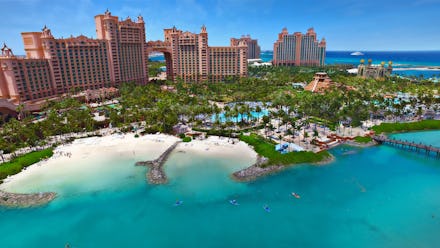This resort is on a mission to save endangered fish in the Caribbean

Grab a snorkel or scuba gear, head under the surface of the Caribbean, and you’re bound to catch a glimpse of the sea’s vast biodiversity. After all, according to the Caribbean Challenge Initiative, the Caribbean is home to 1,400 species of fish and marine mammals, and extensive coral reefs and coastal mangroves that provide shelter and nutrients for the wildlife. But as extensive as this underwater ecosystem is, things like overfishing, commercial development and climate change are threatening the existence of some of the animals that call it home. The smalltooth sawfish, a large ray with a long, tooth-covered snout resembling a saw, is one of them. The “saw” makes it easy for the fish to get entangled and accidentally caught in fishermen’s nets; and that, along with the loss of mangrove trees (the sawfish’s natural habitat) and occasional poaching, has contributed to the marine animal’s endangerment, according to Oceana.
The fish is listed as critically endangered by the International Union for Conservation of Nature and Natural Resources (IUCN); and while they could once be found in waters all the way from Texas to New York, the population of smalltooth sawfishes has steadily declined over the years. Today, they are only confirmed to live and breed in a few places around the world, including Florida and the Bahamas — the latter of which is also home to Atlantis, Paradise Island, where a team of more than 100 experts work year-round to protect the smalltooth sawfish.
The sprawling island resort includes the largest open-air marine habitat in the world — with 14 lagoons, eight million gallons of ocean water and more than 50,000 aquatic animals representing more than 250 marine species — which has been home to sawfish since 1996. According to Bahamas Local, the animals initially came from the waters off the west coast of the nearby Andros Island, one of the few places smalltooth sawfish remain, albeit in very small numbers. “We created a sawfish breeding population with three females and one male [and...housed] the mature adults where there was natural sunlight, [proper] water temperature and substrate” said David Wert, aquarium director for the Marine and Aquarium Operations at Atlantis, Paradise Island.
Eventually, they discovered one of the females was pregnant and, in April 2012, successfully facilitated the live birth of four pups. “We are the only marine facility to have had a successful live birth of a sawfish in a manmade habitat,” Wert said. “One day, if we continue to have reproductive success, we would like to release sawfish back into the wild population.” And he expects that to happen; in fact, Wert noted that those pups born in 2012 are now juveniles “that are almost mature and are ready to breed.”
In the meantime, Atlantis’ marine life team continues to research the endangered species and work continuously toward conservation. Earlier this year, the resort hosted biologists from the U.S., Cuba and the Bahamas (some representing organizations such as Havenworth Coastal Conservation, Shark Advocates International, CubaMar and Florida State University) for a “Sawfish Workshop.” During the gathering, the experts discussed the current state of sawfish protection and public education, as well as what it will take to pass legislation protecting sawfish in the Bahamas — and as a result, the group decided Atlantis would host an upcoming “Sawfish Soiree.” “The Soiree is meant to bring NGOs [non-governmental organizations] and government leaders together to help pass laws that would protect sawfish in the Bahamas,” Wert said.
On April 26, 2019, 30 to 40 people — including NGO and government representatives, as well as fishermen, scientists and members of Atlantis’s Marine Team — met at the resort to dive even deeper into sawfish research and conservation plans, and work out an action plan for securing sawfish-specific legal protections.
Much of Atlantis’s research and work surrounding sawfish protection is funded by the Atlantis Blue Project foundation; and visitors to the island can contribute by participating in marine adventures, like snorkeling among sunken ruins and walking underwater among sharks. “We donate proceeds from guest interactions to our conservation initiative, the Blue Project, [which] supports marine research all over the world,” Wert said.
As for the sawfishes specifically, Atlantis regularly lets visitors in on the excitement of the growing pups: “We celebrate our sawfish birthday every year, [when] guests are educated on the biology and plight of sawfish,” Wert said.
Travelers who want to help the cause from afar can donate to the Blue Project Foundation; and, Wert added, everyone can do their part to curb ocean pollution and habitat destruction. Even if you live in a landlocked city or state, you can make choices to avoid single-use plastic (and keep pieces you already have out of the trash) and support sustainability-minded companies whenever possible (including when you travel). “At the resort, we have policies for getting rid of all single-use plastics because plastics are one of the main items that are problematic for marine species,” Wert said. “[For example], sea turtles and marine animals see a plastic bag floating in the wild they will think it’s a jellyfish.”
If you live near a coastal area, Wert recommends linking up with a local conservation group to join in on actions like beach cleanups. And, he added, “another thing travelers can do is get involved with local government — especially if you live in coastal areas — and try to limit coastal development that [is] detrimental to mangrove habitats and marine species.”
*This post has been updated due to transcription errors.*